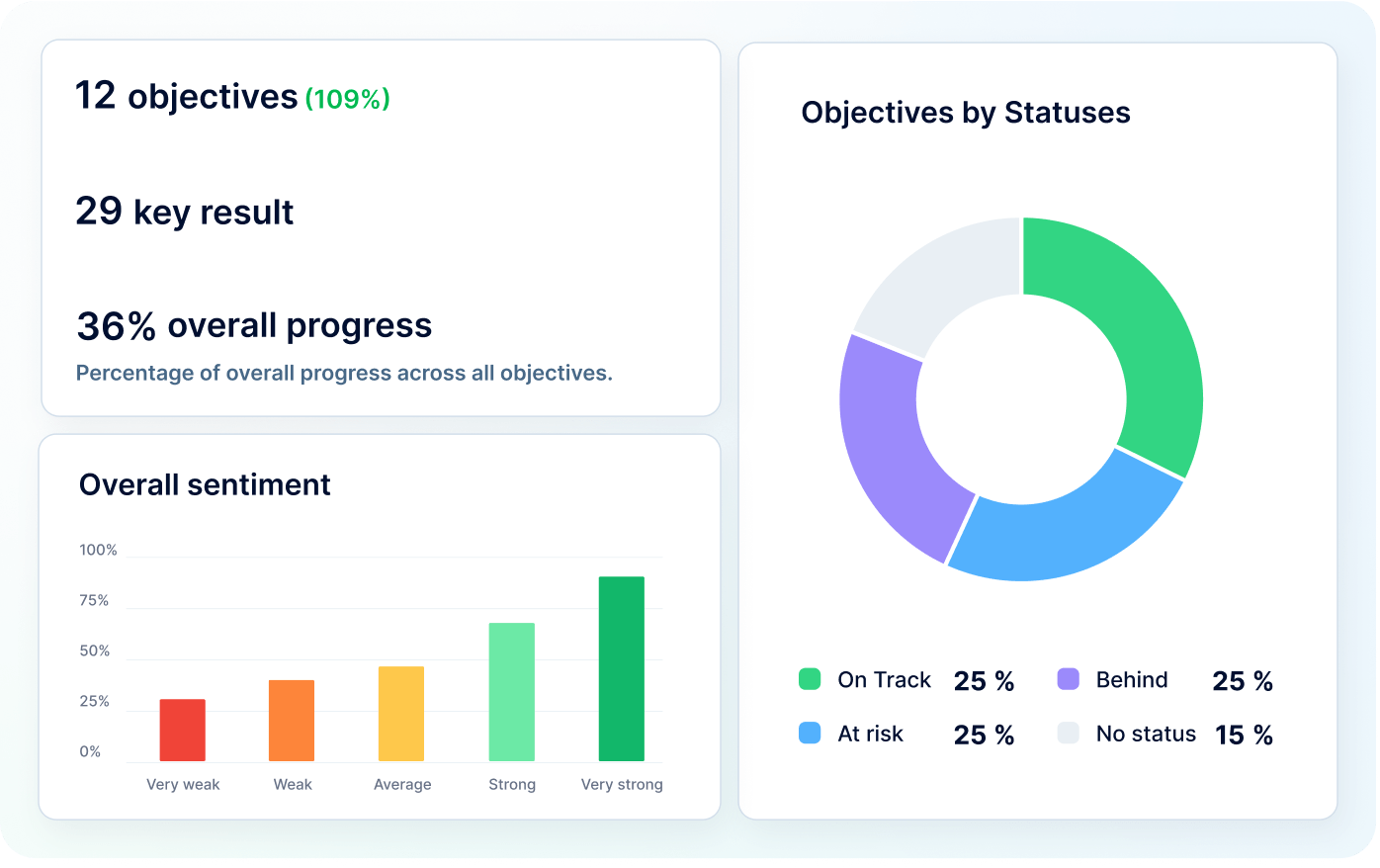
Why OKRs feel like hell (and how to make them simple)
You know the feeling: performance review season approaches, and suddenly everyone scrambles to recall what goals were set months ago. Spreadsheets multiply, alignment conversations happen in hallways, and HR teams spend countless hours chasing updates instead of driving strategic initiatives. Meanwhile, operational work keeps piling up, leaving little room for structured goal management.
It's that time of year again when companies start thinking about goals, OKRs, and performance frameworks. And just as predictably, many will decide to skip the whole thing. Again.
Not because they don't understand the value or don't want alignment. But because the mere thought of implementing structured goal setting feels like signing up for organizational hell.
Why is that so and how to avoid it essentially? Let’s find out.
The meeting that killed OKRs
Let me paint you a picture.
It's Monday morning. Sarah, a department head at a 150-person tech company, sits down with her laptop and a strong coffee. Her mission is to consolidate team objectives for Q1. Sounds simple enough, right?
Three hours later, she's drowning in 15 different spreadsheets, each with a slightly different format. One manager used percentages for key results. Another used absolute numbers. A third person somehow turned objectives into a task list. None of them align with the company priorities that leadership shared three weeks ago – because those priorities are buried in a Slack thread that half the team missed.
Sarah spends another two hours trying to create alignment, scheduling sync meetings with other department heads to ensure no duplication of effort. By Wednesday, she finally has a consolidated view. She sends it to leadership for approval. But on Friday, the CEO announces a strategic pivot – and everything needs to be reworked.
Sarah looks at her calendar: 8 hours spent on goal setting. The same 8 hours she could have spent actually managing, coaching, or driving initiatives forward.
This is the moment OKRs die in most companies. Not with a dramatic failure, but with exhausted managers quietly deciding: "This isn't worth it."
The real reasons companies avoid structured goals
Here's what we hear constantly from HR leaders, managers, and founders when they explain why they're not implementing formal OKR frameworks:
1. "It seems too complex for our company."
This is code for: "I've seen what 'proper' OKR implementation looks like at Google or LinkedIn, and we're not them."
The myth is that OKRs require:
- Extensive training programs
- Dedicated OKR champions in every department
- Sophisticated cascading models
- Expensive consultants
- Enterprise-grade software with a learning curve steeper than Everest
And you know what? This perception isn't entirely wrong. Many companies DO over-engineer OKR implementation, turning a framework meant to create clarity into a bureaucratic monster that generates confusion.
The irony: growing companies that would benefit most from structured alignment are the ones most intimidated by the perceived complexity.
2. "We're already doing goal setting."
Translation: "We have annual performance reviews where people set development goals, and that feels like enough."
Sure, you're tracking that John wants to improve his public speaking skills and Maria plans to complete a leadership course. But here's the uncomfortable question: How do any of these individual development goals connect to whether your company hits its revenue target, launches that new product, or improves customer retention by 15%?
Individual development planning is valuable. Strategic goal alignment is essential. They're not the same thing, and pretending one substitutes for the other is how companies drift off course while everyone is busy "growing.
3. "We don't have time to add another process."
This is the most honest objection, and it reveals the core problem.
When managers hear "we're implementing OKRs," they hear:
- Another mandatory weekly meeting
- Another system where I have to update something
- Another reason my team will complain about bureaucracy
- Another metric I'll be judged on
- Another initiative that will be forgotten in three months
And here's the brutal truth: they're not wrong to be skeptical.
Without proper infrastructure, OKRs do become another burden. Another spreadsheet to maintain and another checkbox to tick.
Let's do the math: The real cost of manual OKRs
Here's what nobody talks about when discussing OKR implementation – the actual time cost. Let's count:
- Goal setting (Week 1)
Workshops, writing sessions, alignment meetings, revisions, approvals.
Time: 12-15 hours per manager
- Progress tracking (Weeks 2-12)
Weekly check-ins, hunting for updates across tools, manual data entry, chasing teams for status reports.
Time: 2-3 hours per week × 11 weeks = 24-36 hours per manager
- Performance reviews (Week 13)
Compiling scattered data, trying to recall what actually happened, reconciling goals with reality.
Time: 10-15 hours per manager
❌Total: 46-66 hours per manager per quarter❌
That's more than a full work week spent on goal administration – not on strategy, not on achieving goals, but on tracking and coordinating them manually.
Now multiply this by the number of managers in your company. A company with 20 managers burns 920-1,320 hours per quarter on OKR admin alone. That's nearly $50,000-70,000 in salary costs (at average manager rates) spent on spreadsheet wrangling.
Suddenly, it's crystal clear why companies avoid "structured goal setting." But what if the problem isn't goal setting itself?
What if we've just been doing it wrong this entire time?
The truth bomb: OKRs aren't hard. Bad implementation is.
Here's what nobody tells you: the problem isn't OKRs. The problem is manual implementation.
When companies struggle with OKRs, they're almost always fighting the wrong battle. They're trying to:
- Manually cascade goals across levels
- Track progress in spreadsheets and status meetings
- Coordinate alignment through endless meetings
- Connect goals to performance reviews through heroic HR admin work
It's like trying to manage modern software development with pen and paper. Sure, it's technically possible. But why would you?
The OKR software market is projected to grow from $1.15 billion in 2023 to $2.98 billion by 2030. That's not because software companies have great marketing. It's because companies are realizing: the manual approach is the problem.
What actually works: The automated reality
With proper automation, here's what the OKR process actually looks like:
Setting goals (15 minutes)
- Leadership or managers set 3–5 company objectives in the system
- A few key metrics (KPIs) can be added to each objective to track progress
- Managers can leave a note or comment to clarify what specific outcomes or changes are expected for each objective
- The system automatically notifies all members affected
Total setting time: 30 minutes
Tracking progress (Almost zero effort)
- The system reminds users to update objectives – sending smart reminders only when action is needed
- Goal progress is updated in real time for everyone
- A dashboard displays progress, accessible to anyone who needs visibility
- The system shows the status of each objective – on track, behind, or at risk
Manager time per week: 5 minutes to review
HR time per week: Zero (it's automatic)
Performance Reviews (90% faster)
- You start the new Performance Review cycle
- System pulls all relevant OKR progress, with context and evidence
- Manager adds qualitative observations
- Done
HR prep time: 2 hours total for entire company (vs. 40+ hours)
Manager prep time per review: 15 minutes (vs. 2-3 hours)
The real difference
Without automation:
- 46-66 hours per manager per quarter on goal admin
- Data always outdated
- Alignment constantly drifting
- Performance reviews disconnected from actual work
- HR drowning in coordination
With automation:
- 2-3 hours per manager per quarter on goal admin
- Real-time data always available
- Automatic alignment checking
- Performance reviews directly connected to documented goal progress
- HR actually doing strategic work
The difference isn't marginal. It's transformational.
Setting OKRS, but simple (this time – for real!)
The most common mistake in OKR implementation is trying to achieve perfection immediately. Companies attempt sophisticated cascading models, complex weighting systems, and comprehensive tracking before establishing basic rhythms.
Here's the actually simple path:
Phase 1: Establish company-level cycles
- Set 3-5 company objectives for one quarter
- Use HR automation to notify teams
- Focus on outcomes, not activities
- Don't worry about cascading yet
- Just build the habit
Success metric: Leadership agrees on objectives, communicates them company-wide, automation sends one mid-quarter progress reminder.
💡 Estimated impact: Saves 8–12 hours per quarter for leadership teams by automating communication and reminders instead of holding manual update meetings.
Phase 2: Add team-level goals
- Invite teams to define 1-3 objectives that support company goals
- Use system templates
- Allow flexibility
- Automatic check-ins collect progress
Success metric: Each team creates aligned objectives without extensive meetings or manual coordination.
💡 Estimated impact: Reduces coordination time by 15–20 hours per team per quarter, eliminating manual reporting and cross-department sync calls.
Phase 3: Introduce real alignment
- System visualizes connections between company and team goals
- Cross-functional dependencies visible on dashboard
- Approval workflows route goals to the right reviewers automatically
Success metric: Clear line of sight from team to company objectives, reduced duplication, improved coordination – all without manual coordination meetings.
💡 Estimated impact: Cuts 20–30% of project planning time, saving roughly 25–35 hours per quarter for mid-level managers and HR leads.
Phase 4: Connect to performance management
- Sync objectives with performance review cycles
- Use OKR progress as the primary data source for reviews
- Connect individual development plans to team objectives
- One HRM system, one source of truth
Success metric: Performance reviews reference specific OKR progress, employees have clear examples of achievement, and HR prepares reviews in a fraction of the time.
💡 Estimated impact: Saves 10–15 hours per manager per quarter on review preparation, plus 30–40% faster HR processing time due to integrated OKR data.
Bonus phase: You can start from scratch by setting individual goals!
Sometimes it’s enough to start simple – even if you begin by setting only individual employee goals without creating large company-wide or departmental plans, that’s perfectly fine. It’s a great first step toward building a goal-setting culture.
- Talk to your employees about their individual goals.
- Define these goals together or let them set their own objectives for the quarter.
- Review and adjust goals if needed to ensure they stay realistic
- Encourage regular updates and celebrate progress through Feedback or Kudos
💡 Estimated impact: Saves 5–8 hours per employee per quarter compared to traditional goal-tracking spreadsheets, while boosting engagement and accountability early on.
Even small wins matter!
So what now?
It's not whether your company needs structured goal setting. Research shows that formal, structured goal-setting processes lead to higher employee engagement, improved workplace well-being, and ultimately higher individual performance.
The real question is: Are you going to keep avoiding OKRs because manual implementation is a nightmare?
Or are you ready to implement them the way they should have been done from the start – with automation doing the heavy lifting?
Because here's the thing: your competitors are figuring this out. The companies that are successfully scaling aren't the ones avoiding structure. They're the ones who've cracked the code on implementation.
The difference between companies where OKRs feel like hell and companies where they drive alignment effortlessly isn't culture, company size, or industry. It's infrastructure.
The good news? Infrastructure is the easy part now. You don't need a dedicated OKR team. You don't need to spend months training everyone. You just need to stop doing manually what technology can do better.
Want to see what automated goal setting actually looks like?
The choice is simple: spend another quarter burning management hours on spreadsheets, or finally implement OKRs the way they were meant to work – automated, seamless, and actually useful.
Your competitors aren't waiting. Neither should you.
Get started with PeopleForce today
Automate your HR routine to create a high performance culture in your company. PeopleForce is your best HRM alternative to stay business driven but people focused.

Recent articles
🎉 PeopleForce Wrapped 2025: a year of HR magic
2025 wasn’t just about shipping features — it was about making HR work better at scale. Let’s unwrap everything we built together.
OKRs vs. KPIs: Choosing the right framework
Unsure when to use OKRs or KPIs? Learn how to choose the right framework to maximize your team’s success.
7 personal development habits worth adopting for career and personal growth
Unlock your potential with 7 simple personal development habits to boost career growth, productivity, and overall life balance.

